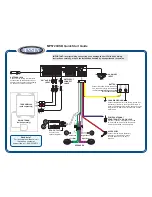
HC 404 System • Hardware Features and Installation
17
Digital I/O
Digital I/O (digital input/output) ports
— To allow the HCR 102 receiver to monitor
devices to trigger events, connect switches, sensors, LEDs, relays, or similar items to
these ports (see
), which can be configured as digital inputs or outputs,
with or w5 VDC pull-up. These ports can trigger events or functions (such as
triggering relays, issuing commands, or sending an e-mail) that have been configured
using Global Configurator. By default these ports are set to digital input mode with
pull-up disabled.
DIGITAL I/O
1 2 G 3 4 G
4
G
3
2
G
1
Digital I/O (digital input/output)
Configure each port as a digital input or output,
with or w5 VDC pull-up. Use these ports to:
• Monitor or trigger events and functions (toggle relays,
issue commands, send e-mail), once configured.
• Trigger LEDs, incandescent lights, or other devices
that accept a TTL signal.
HCR 102
Rear
Panel
Switch,
Sensor
(Switches,
sensors,
LEDs,
relays, or
similar
items)
Ground
Share the
same ground
among I/O
connections.
Device 4
Device 3
Device 2
Device 1
Wire
Nut
Indicator
LED
Figure 7.
Digital I/O Port Wiring Examples
Digital input
— To allow the HCR 102 to monitor external devices that do not use
RS-232 communication, connect a switch, motion sensor, moisture sensor, tally
feedback output, button pad, or a similar item to a digital I/O port and configure it for
digital input. When configured as a digital input, the port is set to measure two states:
high and low. The port accepts 0 to 25.3 VDC input.
Threshold voltages are
not
adjustable. The thresholds are:
•
2.0
VDC — port on, logic low
•
2.8
VDC — port off, logic high
There is also an internal, selectable, pull-up resistor connected to +5 VDC.
Digital output
— To trigger LEDs, lights, or other devices that accept a TTL signal,
or to provide contact closure control for projector lifts, motorized screens, room or light
switches via an Extron IPA T RLY4 or similar device, you can use one or more of these
ports as a digital output. When a port is configured for digital output, it offers two output
states: on and off.
•
When the port is set to an “on” state, (the circuit is closed), the I/O pin is connected
to ground. Output voltage is less than 0.5 volts.
•
When the port is set to the “off” state (the circuit is open), the output pin is not
connected. If the application calls for TTL compatibility, the digital output circuit can
be set up to provide a 2K ohm pull-up resistor to +5 VDC.
•
If the pull-up resistor is
disabled
, voltage output is determined by an external
source device.
•
If the pull-up resistor is
enabled
, voltage output is 4.3 VDC.
Each I/O port is capable of accepting 250 mA, maximum.
















































